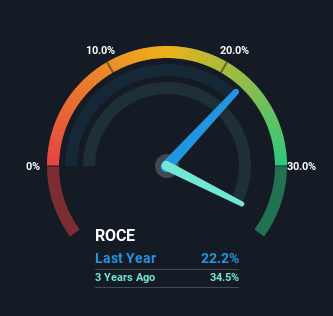- United Kingdom
- /
- Professional Services
- /
- LSE:HAS
Returns On Capital Signal Tricky Times Ahead For Hays (LON:HAS)
To find a multi-bagger stock, what are the underlying trends we should look for in a business? Typically, we'll want to notice a trend of growing return on capital employed (ROCE) and alongside that, an expanding base of capital employed. Ultimately, this demonstrates that it's a business that is reinvesting profits at increasing rates of return. Having said that, while the ROCE is currently high for Hays (LON:HAS), we aren't jumping out of our chairs because returns are decreasing.
Understanding Return On Capital Employed (ROCE)
If you haven't worked with ROCE before, it measures the 'return' (pre-tax profit) a company generates from capital employed in its business. To calculate this metric for Hays, this is the formula:
Return on Capital Employed = Earnings Before Interest and Tax (EBIT) ÷ (Total Assets - Current Liabilities)
0.22 = UK£213m ÷ (UK£2.1b - UK£1.1b) (Based on the trailing twelve months to June 2022).
Thus, Hays has an ROCE of 22%. In absolute terms that's a great return and it's even better than the Professional Services industry average of 15%.
See our latest analysis for Hays

Above you can see how the current ROCE for Hays compares to its prior returns on capital, but there's only so much you can tell from the past. If you'd like, you can check out the forecasts from the analysts covering Hays here for free.
How Are Returns Trending?
When we looked at the ROCE trend at Hays, we didn't gain much confidence. Historically returns on capital were even higher at 35%, but they have dropped over the last five years. However, given capital employed and revenue have both increased it appears that the business is currently pursuing growth, at the consequence of short term returns. And if the increased capital generates additional returns, the business, and thus shareholders, will benefit in the long run.
On a side note, Hays' current liabilities are still rather high at 54% of total assets. This effectively means that suppliers (or short-term creditors) are funding a large portion of the business, so just be aware that this can introduce some elements of risk. While it's not necessarily a bad thing, it can be beneficial if this ratio is lower.
The Key Takeaway
In summary, despite lower returns in the short term, we're encouraged to see that Hays is reinvesting for growth and has higher sales as a result. And there could be an opportunity here if other metrics look good too, because the stock has declined 21% in the last five years. As a result, we'd recommend researching this stock further to uncover what other fundamentals of the business can show us.
If you'd like to know about the risks facing Hays, we've discovered 1 warning sign that you should be aware of.
If you want to search for more stocks that have been earning high returns, check out this free list of stocks with solid balance sheets that are also earning high returns on equity.
Valuation is complex, but we're here to simplify it.
Discover if Hays might be undervalued or overvalued with our detailed analysis, featuring fair value estimates, potential risks, dividends, insider trades, and its financial condition.
Access Free AnalysisHave feedback on this article? Concerned about the content? Get in touch with us directly. Alternatively, email editorial-team (at) simplywallst.com.
This article by Simply Wall St is general in nature. We provide commentary based on historical data and analyst forecasts only using an unbiased methodology and our articles are not intended to be financial advice. It does not constitute a recommendation to buy or sell any stock, and does not take account of your objectives, or your financial situation. We aim to bring you long-term focused analysis driven by fundamental data. Note that our analysis may not factor in the latest price-sensitive company announcements or qualitative material. Simply Wall St has no position in any stocks mentioned.
About LSE:HAS
Hays
Engages in the provision of professional and skilled recruitment services in Germany, the United Kingdom, Ireland, Australia, New Zealand, and internationally.
Excellent balance sheet and fair value.
Similar Companies
Market Insights
Community Narratives



